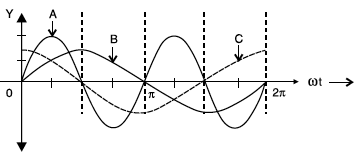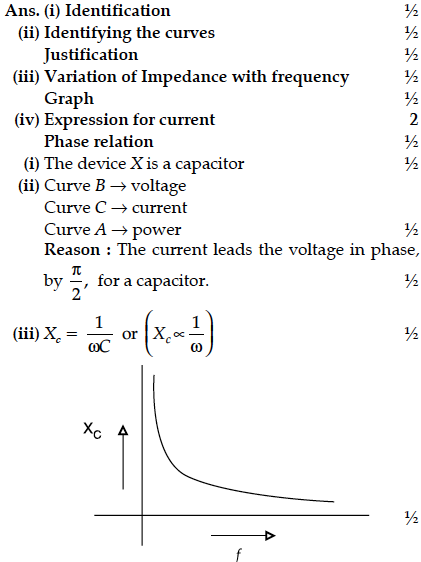A device ‘X’ is connected to an ac source V = The variation of voltage, current and power in one cycle is shown in the following graph :

(i) Identify the device ‘X’.
(ii) Which of the curves A, B and C represent the voltage, current and the power consumed in the circuit ? Justify your answer.
(iii) How does its impedance vary with frequency of the ac source ? Show graphically.
(iv) Obtain an expression for the current in the circuit and its phase relation with ac voltage.

(i) Identify the device ‘X’.
(ii) Which of the curves A, B and C represent the voltage, current and the power consumed in the circuit ? Justify your answer.
(iii) How does its impedance vary with frequency of the ac source ? Show graphically.
(iv) Obtain an expression for the current in the circuit and its phase relation with ac voltage.


A device ‘X’ is connected to an ac source V = V₀ sin(ωt). The variation of voltage, current and power in one complete cycle is shown in the following figure.
(i) Which curve shows power consumption over a full cycle?
(ii) Identify the device ‘X’.
A device X is connected across an ac source of voltage V = V₀ sin ωt. The current through X is given as I = I₀sin(ωt +π/2).
(a) Identify the device X and write the expression for its reactance.
(b) Draw graphs showing variation of voltage and current with time over one cycle of ac, for X.
(c) How does the reactance of the device X vary with frequency of the ac ? Show this variation graphically.
(d) Draw the phasor diagram for the device X.
In the following circuit, calculate (i) the capacitance of the capacitor, if the power factor of the circuit is unity, (ii) the Q-factor of this circuit. What is the significance of the Q-factor in ac circuit ? Given the angular frequency of the ac source to be 100rad/s. Calculate the average power dissipated in the circuit.
(i) When an ac source is connected to an ideal capacitor show that the average power supplied by the source over a complete cycle is zero.
(ii) A lamp is connected in series with a capacitor.Predict your observation when the system is connected first across a dc and then an ac source.What happens in each case if the capacitance of the capacitor is reduced ?
An inductor L of inductance is connected in series with a bulb B and an ac source. How would brightness of the bulb change when
(i) number of turns in the inductor is reduced,
(ii) an iron rod is inserted in the inductor and
(iii) a capacitor of reactance is inserted in series in the circuit. Justify your answer in each case.
(i) When an ac source is connected to an ideal inductor shows that the average power supplied by the source over a complete cycle is zero.
(ii) A lamp is connected in series with an inductor and an ac source. What happens to the brightness of the lamp when the key is plugged in and an iron rod is inserted inside the inductor ? Explain.
The current, in the LCR circuit shown in the figure is observed to lead the voltage in phase. Without making any other change in the circuit, a capacitor,of capacitance C₀, is (appropriately) joined to the capacitor C. This results in making the current,in the ‘modified’ circuit, flow in phase with theapplied voltage.
Draw a diagram of the ‘modified’ circuit and obtain an expression for C₀ in terms of ω, L and C.
(a) Draw graphs showing the variations of inductive reactance and capacitive reactance with frequency of the applied ac source.
(b) Draw the phasor diagram for a series RC circuit connected to an ac source.
(c) An alternating voltage of 220 V is applied across a device X, a current of 0.25 A flows, which lag behind the applied voltage in phase by π/2
radian.If the same voltage is applied across another device Y, the same current flows but now it is in phase with the applied voltage.
(i) Name the devices X and Y.
(ii) Calculate the current flowing in the circuit when the same voltage is applied across the series combination of X and Y.
A device X is connected across an ac source of voltage V = V₀ sin ωt. The current through X is given as I = I₀sin(ωt +π/2).
(a) Identify the device X and write the expression for its reactance.
(b) Draw graphs showing variation of voltage and current with time over one cycle of ac, for X.
(c) How does the reactance of the device X vary with frequency of the ac ? Show this variation graphically.
(d) Draw the phasor diagram for the device X.
In the following circuit, calculate (i) the capacitance of the capacitor, if the power factor of the circuit is unity, (ii) the Q-factor of this circuit. What is the significance of the Q-factor in ac circuit ? Given the angular frequency of the ac source to be 100rad/s. Calculate the average power dissipated in the circuit.
Derive an expression for potential due to a dipole for distances large compared to the size of the dipole. How is the potential due to dipole different from that due to single charge ?
(i) Two isolated metal spheres A and B have radii R and 2R respectively, and same charge q. Find which of the two spheres have greater :
(a) capacitance and
(b) energy density just outside the surface of the spheres.
(ii) (a) Show that the equipotential surfaces are closed together in the regions of strong field and far apart in the regions of weak field. Draw equipotential surfaces for an electric dipole.
(b) Concentric equipotential surfaces due to a charged body placed at the centre are shown. Identify the polarity of the charge and draw the electric field lines due to it.
An ac voltage V = V₀ sin ωt is applied to a pure inductor L. Obtain an expression for the current in the circuit. Prove that the average power supplied to an inductor over one complete cycle is zero.
(i) Why do the 'free electrons', in a metal wire, 'flowing by themselves', not cause any current flow in the wire ?
Define 'drift velocity' and obtain an expression for the current flowing in a wire, in terms of the 'drift velocity' of the free electrons.
(ii) Use the above expression to show that the 'resistivity', of the material of a wire, is inversely proportional to the 'relaxation time' for the 'free electrons' in the metal.
